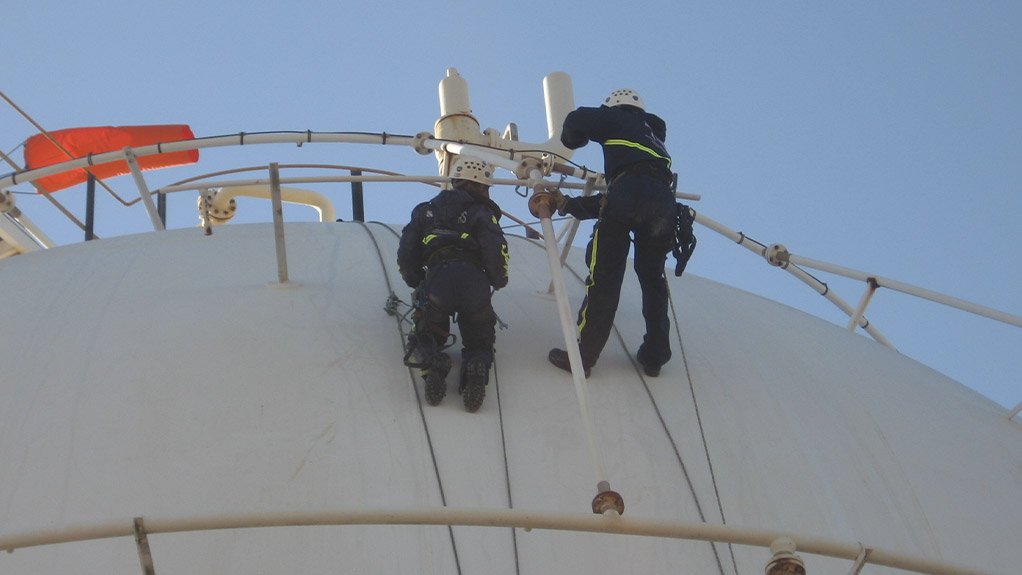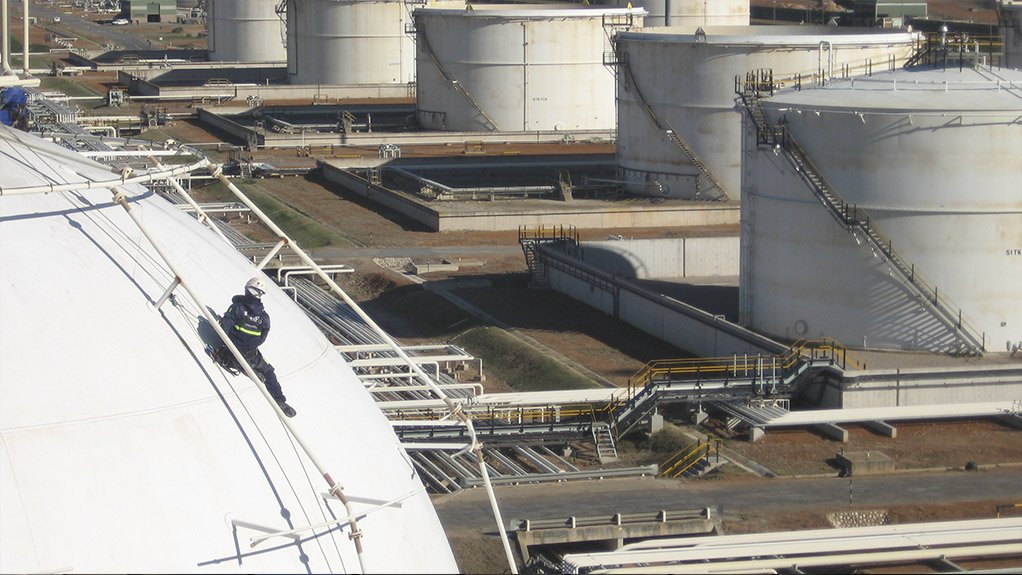Interior tank cleaning made easier through rope access



ROPING IN THE PROS In many cases, a client’s maintenance and inspection budgets can be stretched further by using rope access
HIGH ON GAS Rope access is a quicker and more cost effective means of maintaining the large petrochemical tanks
Work at height company Skyriders is cleaning the interiors of large storage tanks for a major petrochemicals producer, in Mpumalanga, using rope access.
Having completed its first cleaning scope of the year in February, it started its second cleaning in late March.
The work involves cleaning residue build-up from the 16-m-high ceiling and walls of the 40-m-diameter tanks using a combination of mechanical scraping and high-pressure washing.
The team uses an Elios confined-space drone to assess the structure’s rope-access attachment points before rigging and starting work.
Skyriders marketing manager Mike Zinn tells Engineering News that previously, the client would erect large scaffolding inside the tanks to enable a separate cleaning contractor to perform the task.
He adds that an eight-man Skyriders team working a 12-hour day shift completed the first tank in eight days. A separate contractor was appointed for a 12-hour night shift to clean the debris that accumulated on the ground during the day.
“Without the need for scaffolding, we are able to drastically reduce the amount of time it takes to perform this task,” he says, noting that, by comparison, it would take a good few days merely to build the scaffolding necessary to start the work.
Zinn says using the traditional method of access could amount to more than R3-million, whereas Skyriders completed the task for less than R1.5-million.
“Initially, we were on call as an emergency backup plan for tanks that needed cleaning or maintenance, whether on the interior or exterior, at short notice. However, as we have proved our value, we have become more the one-stop shop and the first port of call for a large number of maintenance and refurbishment projects for the client.”
He adds that tank cleaning scope is a good example of the advantages of using rope access when the cost of access is disproportionate to the scope of work.
Zinn claims that, in many cases, a client’s maintenance and inspection budgets can be stretched further by using rope access. The client will now consider only rope access. Scaffolding is considered only when multiple specialised contractors are required for complex and varied tasks.
He adds that the petrochemical producer’s tank farm has more than 150 large-scale vessels at various stages of maintenance, which means that Skyriders is kept busy.
Having a Blast
In October and November last year, Skyriders used ultrahigh-pressure blasting to systematically remove a layer of cementitious fireproofing and insulating material from a 19-m-diameter, 22-m-high spherical gas storage tank for the same client.
The complete scope of work was, firstly, to remove the deluge fire sprinkler and piping system before the cementitious fireproofing insulation material could be accessed from the top of the structure downwards, Zinn explains.
The pressurised storage tank requires statutory inspection and testing every few years, in addition to replacing the fireproofing and insulating material to ensure the ongoing integrity of the structure.
Skyriders was tasked with devising a safe and efficient means of achieving this to enable third-party contractors to carry out the reapplication of fireproofing and insulation.
An eight-person team from Skyriders took 18 days to complete the project, after which the deluge fire sprinkler and piping system had to be put back in place.
The major challenge was carrying out high-pressure blasting at height, which Zinn says required training and accreditation, as well as specialised protective gear. The process was monitored closely by our safety team, as well as the client and its safety team.
For a similar prior project, the client chose to use the more traditional means of access, which meant that the project took much longer to complete and required a larger team, which poses its own challenges with regards to safety.
The key differentiator for Skyriders is that it can offer a per-square-metre rate that represents a 20% to 35% saving on maintenance budgets, in addition to benefits such as enhanced health and safety.
A Flare for High Work
The same client also houses flare stacks, which require regular inspection and maintenance, on its large tank farm. These flare stacks range from 50 m to 80 m in height. Their function is to burn off surplus or dangerous excess gases that cannot be used or stored.
Traditionally, sizeable cranage needs to be mobilised to lift the necessary equipment and personnel to the top to carry out the work required. This has significant implications in terms of cost, efficiency and safety, Zinn explains.
In September last year, Skyriders assisted during a shutdown of a major flare stack to carry out ultrasonic (UT) wall-thickness testing.
Prior to this, the five-person team was required to remove all damaged lagging and cladding, and then replace it with new material.
“Our challenge was to ensure that our methodology was planned correctly,” Zinn explains. Skyriders was called upon only in the final days of the shutdown, which added an element of time pressure.
UT wall thickness measurement is a specialist inspection service offered by Skyriders, which has technicians trained specifically in this regard.
UT measurement comprises the nondestructive testing of the local thickness of a solid element, such as a wall, based on the time taken by the ultrasound waves to return to the surface. This measurement is determined by an ultrasonic thickness gauge.
Zinn believes that the successful completion of these tasks will lead to much more work in the petrochemicals sector in future.
Article Enquiry
Email Article
Save Article
Feedback
To advertise email advertising@creamermedia.co.za or click here
Comments
Announcements
What's On
Subscribe to improve your user experience...
Option 1 (equivalent of R125 a month):
Receive a weekly copy of Creamer Media's Engineering News & Mining Weekly magazine
(print copy for those in South Africa and e-magazine for those outside of South Africa)
Receive daily email newsletters
Access to full search results
Access archive of magazine back copies
Access to Projects in Progress
Access to ONE Research Report of your choice in PDF format
Option 2 (equivalent of R375 a month):
All benefits from Option 1
PLUS
Access to Creamer Media's Research Channel Africa for ALL Research Reports, in PDF format, on various industrial and mining sectors
including Electricity; Water; Energy Transition; Hydrogen; Roads, Rail and Ports; Coal; Gold; Platinum; Battery Metals; etc.
Already a subscriber?
Forgotten your password?
Receive weekly copy of Creamer Media's Engineering News & Mining Weekly magazine (print copy for those in South Africa and e-magazine for those outside of South Africa)
➕
Recieve daily email newsletters
➕
Access to full search results
➕
Access archive of magazine back copies
➕
Access to Projects in Progress
➕
Access to ONE Research Report of your choice in PDF format
RESEARCH CHANNEL AFRICA
R4500 (equivalent of R375 a month)
SUBSCRIBEAll benefits from Option 1
➕
Access to Creamer Media's Research Channel Africa for ALL Research Reports on various industrial and mining sectors, in PDF format, including on:
Electricity
➕
Water
➕
Energy Transition
➕
Hydrogen
➕
Roads, Rail and Ports
➕
Coal
➕
Gold
➕
Platinum
➕
Battery Metals
➕
etc.
Receive all benefits from Option 1 or Option 2 delivered to numerous people at your company
➕
Multiple User names and Passwords for simultaneous log-ins
➕
Intranet integration access to all in your organisation




















